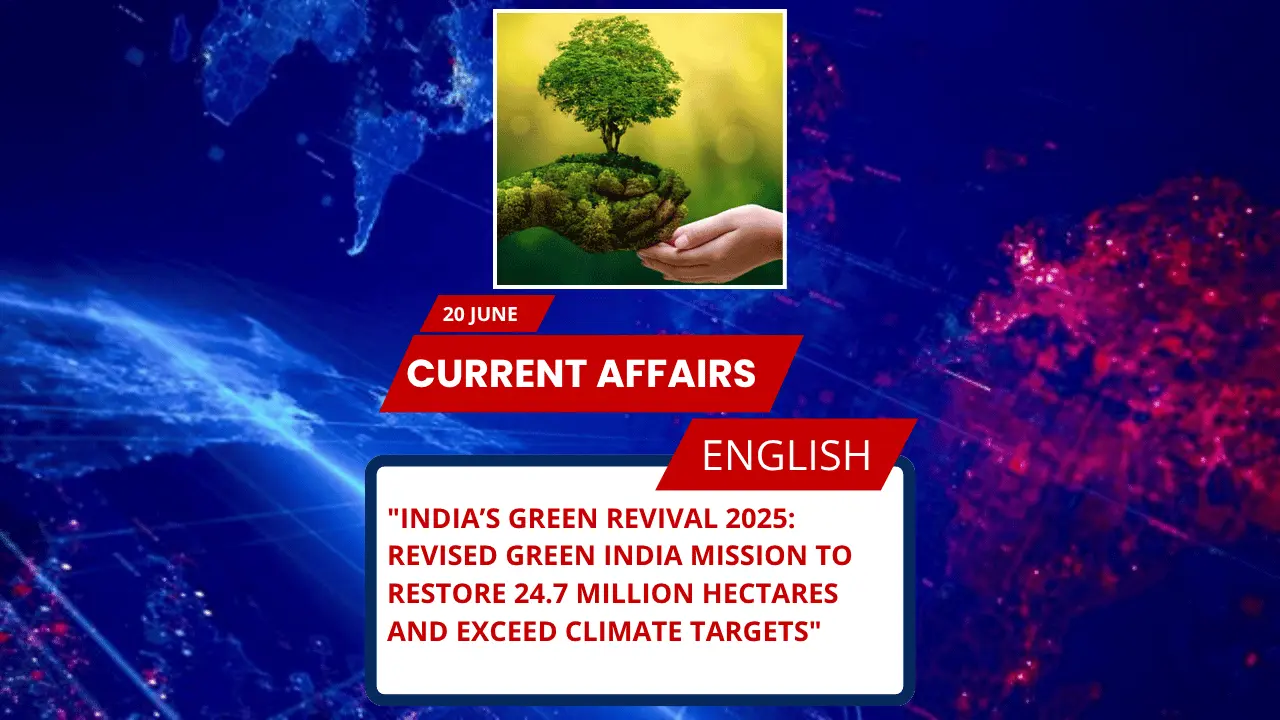
Key Points for SSC/UPSC and Other Government Exams
- Green India Mission (GIM) launched in 2014 under National Action Plan on Climate Change (NAPCC).
- Revised GIM roadmap released in 2025 by the Centre.
- Targets restoration of 24.7 million hectares of forest and green cover by 2030.
- Aligns with India’s climate targets under UNFCCC.
- Estimated cost of Aravalli Green Wall Project: ₹16,053 crore.
- Focus areas: Aravalli ranges, Western Ghats, Himalayas, Mangroves.
- Total land degraded in India: 97.85 million hectares (ISRO Atlas, 2018–19).
- India’s carbon sink achievement (2005–2021): 2.29 billion tonnes CO₂ equivalent.
- Goal: Create additional carbon sink of 2.5–3 billion tonnes CO₂ by 2030.
Revised Green India Mission – Complete Details
Background and Purpose
The Green India Mission (GIM) is one of the eight core missions under the National Action Plan on Climate Change (NAPCC), launched in 2014. Its primary goals were to:
- Increase forest/tree cover on 5 million hectares.
- Improve forest quality on another 5 million hectares.
- Restore degraded ecosystems and support forest-dependent communities.
Why Was GIM Revised in 2025?
The Centre revised the GIM roadmap to:
- Tackle increasing climate impacts on ecosystems.
- Respond to feedback from states and scientific institutions.
- Enhance restoration in vulnerable ecological regions.
- Align GIM with India’s international climate commitments.
Key Features of the Revised Green India Mission
Region-Specific Approach
- The plan adopts a landscape-level, ecologically tailored strategy.
- Priority regions include:
- Aravalli ranges
- Western Ghats
- Indian Himalayas
- Mangrove ecosystems
Integration with Aravalli Green Wall Project
- Objective: Combat desertification, dust storms, and ecological degradation.
- Scope:
- Restore 8 lakh hectares across 29 districts in 4 states.
- Create a 5-km green buffer zone spanning 6.45 million hectares.
- Cost: ₹16,053 crore.
- Focus: Use of native species, grassland and waterbody restoration.
Focus in the Western Ghats
- Combat illegal mining and deforestation.
- Prioritize eco-restoration, afforestation, and groundwater recharge.
Achievements and Funding (2015–2024)
- Total afforestation: 11.22 million hectares under central and state schemes.
- Budget allocated (2019–2024): ₹624.71 crore to 18 states.
- Utilization: ₹575.55 crore (approx. 92%).
India’s Climate Goals and GIM’s Role
- Under UNFCCC, India pledged to:
- Restore 26 million hectares of degraded land.
- Create an additional carbon sink of 2.5–3 billion tonnes of CO₂ by 2030.
- As of 2021, India had already achieved 2.29 billion tonnes of carbon sink.
- Open forests identified as high-impact zones for carbon absorption.
Revised GIM’s Carbon Sequestration Potential
- With integrated schemes and revised strategy:
- Expand forest/tree cover to 24.7 million hectares.
- Create a carbon sink of 3.39 billion tonnes CO₂—exceeding targets.
State & Organization Facts for Exams
India
- Capital: New Delhi
- PM: Narendra Modi
- Environment Ministry: Bhupender Yadav (MoEFCC)
- Forest Survey of India (FSI) Headquarters: Dehradun
- ISRO: Developed the Desertification and Land Degradation Atlas
- ISRO HQ: Bengaluru
UNFCCC (United Nations Framework Convention on Climate Change)
- Established: 1992 (Rio Summit)
- HQ: Bonn, Germany
- India is a signatory
- Oversees climate commitments and carbon sink pledges
Exam-Oriented MCQs
Q1. When was the Green India Mission (GIM) launched?
A. 2008
B. 2014
C. 2017
D. 2020
Answer: B
Q2. What is the estimated cost of the Aravalli Green Wall Project?
A. ₹5,000 crore
B. ₹10,000 crore
C. ₹16,053 crore
D. ₹22,500 crore
Answer: C
Q3. Which region is NOT specifically prioritized in the revised GIM?
A. Aravalli ranges
B. Sundarbans
C. Thar Desert
D. Western Ghats
Answer: C
Q4. What is India’s pledged additional carbon sink target by 2030?
A. 1–2 billion tonnes CO₂
B. 2.5–3 billion tonnes CO₂
C. 3.5–4 billion tonnes CO₂
D. None of the above
Answer: B
Q5. What proportion of land in India was degraded as per ISRO’s latest atlas?
A. One-fourth
B. One-third
C. Half
D. Two-thirds
Answer: B
UPSC-style FAQs (Answer Writing Format)
Q1. What are the key objectives and revised strategies of the Green India Mission (GIM) in 2025?
Answer:
The Green India Mission (GIM), launched in 2014 under the National Action Plan on Climate Change (NAPCC), aimed to increase forest and tree cover by 5 million hectares and improve the quality on another 5 million hectares. The 2025 revision adopts a region-specific, ecologically tailored strategy to combat land degradation and align with India’s climate goals under the UNFCCC. Key features include restoration of vulnerable landscapes such as the Aravalli ranges, Himalayas, Western Ghats, and mangroves, integration with the ₹16,053 crore Aravalli Green Wall Project, and a projected expansion of forest/tree cover to 24.7 million hectares. The mission now plays a pivotal role in achieving India’s commitment to create a carbon sink of 2.5–3 billion tonnes of CO₂ by 2030.
Q2. How does the revised Green India Mission contribute to India’s international climate commitments under the UNFCCC?
Answer:
The revised GIM directly supports India’s international climate commitments under the United Nations Framework Convention on Climate Change (UNFCCC), specifically the restoration of 26 million hectares of degraded land and creation of an additional carbon sink of 2.5–3 billion tonnes of CO₂ by 2030. With the incorporation of large-scale afforestation, region-specific ecological restoration, and alignment with projects like the Aravalli Green Wall, GIM is expected to generate a carbon sink of 3.39 billion tonnes CO₂—surpassing India’s target. Furthermore, this enhances India’s climate resilience and strengthens its credibility in global environmental governance.
Q3. What are the implications of integrating the Aravalli Green Wall Project into the Green India Mission?
Answer:
The integration of the Aravalli Green Wall Project into GIM reflects a strategic move to tackle regional ecological degradation and desertification, especially in Delhi-NCR and Punjab. By restoring 8 lakh hectares across 29 districts and establishing a 5-km green buffer zone, the project aims to close 12 ecological gaps contributing to dust storms and land degradation. This effort, costing ₹16,053 crore, will use native species and restore forests, grasslands, and water systems. This not only enhances carbon sequestration but also addresses the pressing issue of desertification and provides long-term ecological stability in North India.







